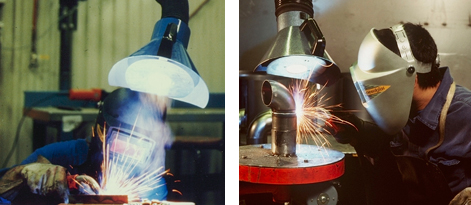Breathing welding fumes is extremely harmful and exposes the lung to great hazards. The welding fumes consist of a mixture of dust, gases and water molecules, which due to their small sizes get into the respiratory system.
 Pictures: Welding with source extraction from Dustcontrol.
Pictures: Welding with source extraction from Dustcontrol.
What do the welding fumes consist of?
The composition of the fumes is dependent of the respective welding method and the material to be welded. Especially in metal-arc welding huge amounts of metal dust is released.
How big are the particles in welding fumes?
The particles in welding fume are about 0.0001 mm in size. Due to the high concentration of the particles they become visible as fumes or smoke. These fumes leads to a weakening of the lung function, as it is a big burden for the respiratory system and the respiratory tract.
Hazards while welding stainless steel
During welding of stainless steel is, amongst others, chromium and nickel released. These substances are carcinogenic and develop cancer.
Symptoms due to breathing welding fumes
- Fatigue
- Trouble of breathing
- Shortness of breath
- Bronchitis
- Eye irritation
- Sensitivity to light
Also ozone is created by welding!
Ozone is created by the high temperatures used especially whilst welding with a gas-arc. This often causes welders to have symptoms in the respiratory tract.
Extensive poisoning during welding
Depending on the used alloy, welders can be exposed to various toxic substances, eg. manganese oxide, lead oxide and cadmium oxide. When welding galvanized sheets, the air breathed in causes the so called metal fume fever aka brass shakes or zinc shakes.
Symptoms of metal fume fever
The symptoms of are nonspecific but are generally flu like including: Fever, chills, nausea, headache, fatigue, muscle aches, and joint pains.
Symptoms will normally disappear within 24 to 48 hours, and someone suffering from metal fume fever will usually feel well enough return to work the next day despite the fact that they may still be feeling a little bit under the weather.
Remedy against diseases caused by welding
Effective prevention of diseases caused by welding can only be achieved via an appropriate and effective extraction system. Here it should be noted that the fumes should be extracted preferably at the source (source extraction) for maximum effect prior to the air being breathed in.
Primary methods to decrease welding fumes
- MIG/MAG-torches with integrated suction
- Fume extraction arms
- Ventilated helmets with fresh air supply
Secondary methods to decrease welding fumes
- Additional ventilation
Only by applying the primary methods can you comply with the regulations on the maximum occupational exposure limits.
Have a look at the Welder’s Guide to the Hazards of Welding Gases and Fumes...
Watch a clip of the dangers with dust and welding fumes and how to protect your coworkers.
An article in an article series of dust in seven parts
- Dust: The Invisible Danger
- Dust: The Causes
- Dust: Hazard of Asbestos
- Dust: Hazard of Silicosis
- Dust: Hazards in Welding
- Dust: Hazard of Asthma in Bakeries
- Dust: Special Techniques to Avoid Asthma in Bakeries
By Thomas Pfister, expert commentator in occupational safety at experto.de
 United Kingdom
United Kingdom  Sverige
Sverige  Deutschland
Deutschland  Suomi
Suomi  Austria
Austria  United States
United States  .com
.com  France
France 
 01327 858002
01327 858002
